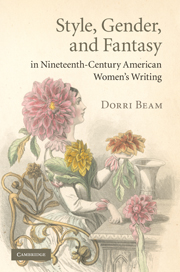Book contents
- Frontmatter
- Contents
- Acknowledgements
- Introduction. Highly wrought style
- 1 Florid fantasies: Fuller, Stephens, and the “other” language of flowers
- 2 Sensing the soul: mesmerism, feminism, and highly wrought fiction
- 3 Harriet Prescott Spofford's philosophy of composition
- 4 Pauline Hopkins' baroque folds: the styled form of Winona
- Coda: The value of ornament: Gilman and Wharton
- Notes
- Bibliography
- Index
Coda: The value of ornament: Gilman and Wharton
Published online by Cambridge University Press: 05 October 2010
- Frontmatter
- Contents
- Acknowledgements
- Introduction. Highly wrought style
- 1 Florid fantasies: Fuller, Stephens, and the “other” language of flowers
- 2 Sensing the soul: mesmerism, feminism, and highly wrought fiction
- 3 Harriet Prescott Spofford's philosophy of composition
- 4 Pauline Hopkins' baroque folds: the styled form of Winona
- Coda: The value of ornament: Gilman and Wharton
- Notes
- Bibliography
- Index
Summary
Hopkins is certainly not the only writer to return to highly wrought style and assess its value for a later moment. Hopkins finds its mediation of spirit and sense particularly salient regarding her quest for a more capacious and just embodiment of African American female desire, and she adapts highly wrought techniques to her innovation of a new generic as well as stylistic form. Hopkins' contemporaries Charlotte Perkins Gilman and Edith Wharton isolate and reflect on another aspect of highly wrought style: they turn specifically to the political efficacy of ornament in highly wrought fiction to interrogate its value for a moment when the middle- and upper-class white woman is increasingly excluded from social and political economy, a position often cast as “ornamental.” Both authors offer a critical meta-reflection on, rather than a stylistic adaptation of, the entwined compositional and social value of ornament as a potential idiom for women's expression and representation.
Gilman most memorably engages the intersection of female expression and ornamentality in “The Yellow Wall-Paper,” and in its predecessor in her oeuvre, “The Giant Wistaria.” The paper and the wisteria, both ornaments of the “arabesque” style (the wallpaper explicitly so) weigh so heavily on their supporting structures – walls and homes that imprison women – that they pull them down quite literally. But the victory is pyrrhic, as Gilman's ornaments also entangle and seem to sacrifice the women whose desire they encode.
- Type
- Chapter
- Information
- Publisher: Cambridge University PressPrint publication year: 2010

